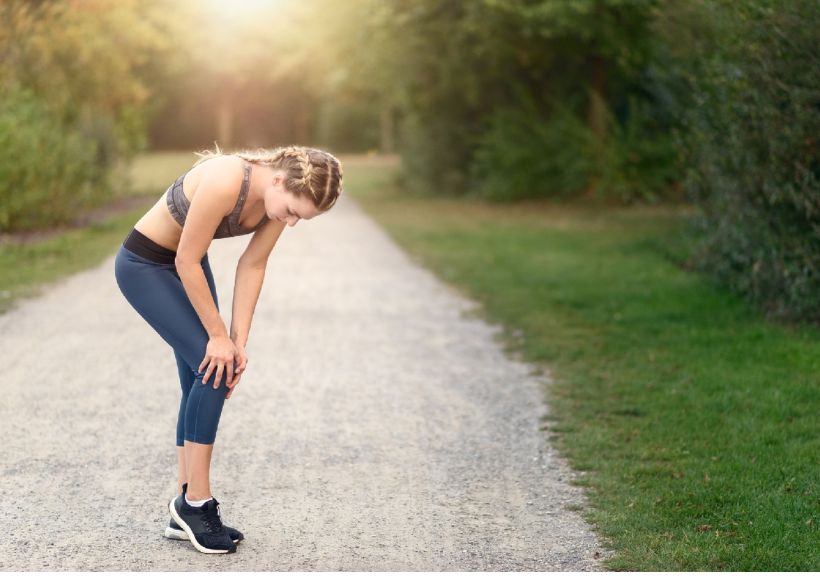Almost every runner has knee pain at some point – runner’s knee is also notorious. This health special explains what’s behind it, which home remedies help and how the doctor treats a painful knee.
Table of Contents
The anatomy of the knee joint
The knee joint is the largest human joint and connects the lower leg to the thigh. As a rotary joint, it flexes and extends, and rotates slightly in and out when angled.
The ends of the thigh and lower leg bones are hinged together in a tight joint capsule. Thanks to its cartilage layer and the viscous synovial fluid in the capsule, the movement of the joint runs smoothly. The crescent-shaped outer and inner mensics between the two ends of the bone cushion shocks and stabilize the movement of the joint as cartilage cushions.
The collateral ligaments on the inside and outside of the joint capsule and the cruciate ligaments on the inside of the knee also provide support . Upper and lower leg muscles are firmly connected to the bones via their tendon ends.
The bony kneecap has grown into the thigh extensor tendon. It helps to transfer the power from the thigh to the lower leg. Bursae filled with synovial fluid are located at heavily stressed areas to cushion tissue structures.
Causes of knee pain while jogging
If knee pain occurs while jogging, this is usually due to excessive or incorrect strain. Unsuitable footwear or a leg deformity such as knock knees or bowlegs can limit the smooth movement of the knee. Running too long, downhill running routes and too short a regeneration time also lead to overloading. If the thigh muscles are weak, the knee joint lacks the necessary support.
Being overweight also puts a lot of strain on the joints. Joint diseases such as arthrosis, arthritis and rheumatism cause pain even at low levels of exertion.
Pain on the inside or outside of the knee?
In principle, overloading in all tissue structures of the knee can lead to irritation, inflammation and pain. Frequent runners often suffer from the so-called runner’s knee, which causes pain on the outside of the knee.
The cause is the repeated sequence of movements when jogging, during which the tendon plate of the thigh slides over the outside of the bony structures of the knee with every step, causing irritation and inflammation.
The symptoms are aggravated by the fact that the thigh muscles in the hip area are shortened in many intensive joggers and the tendon runs very tightly over the knee joint. External knee pain can be caused by damage to the lateral meniscus or lateral ligaments.
Internally, medial meniscus and internal collateral ligaments can cause discomfort. However, such pain is often not clear and cannot be localized more precisely.
First aid for an injured knee
Pain is a signal from the body that something is wrong. Therefore, depending on the extent of the symptoms, you should continue walking slowly or stop the run altogether. The PICK rule is helpful . It provides a break for relief, ice for cooling against swelling and inflammation, compression to stabilize the joint with a bandage and elevation of the joint so that the swelling subsides more quickly.
These remedies help with knee pain
Ice cubes in a plastic bag, ready-made gel pads from the freezer and ice spray are suitable for cooling the knee joint. Curd wraps and poultices with acetic clay also help against swelling and inflammation.
Creams and gels with ibuprofen, diclofenac or comfrey extract are available as ready-to-use preparations. Liquid rubs with essential oils or anti-inflammatory plant extracts contain, for example, rosemary, thyme, spruce needles and mountain pine, and arnica also helps externally with blunt injuries. Homeopathy recommends sports injuries, depending on the individual symptoms, e.g. B. Arnica, Ruta, Rhus toxicodendron and Bryonia.
To stabilize the knee joint, wrap an elastic bandage or use a preformed bandage. Bandages are worn during the day during stress. They are taken off again at night and after the symptoms have improved.
When should you see the doctor?
In the event of acute severe pain and inability to move the knee joint, you should go to the doctor as quickly as possible. Ruptured ligaments, meniscus damage, or kneecap injuries must be evaluated to prevent further damage. If slight to moderate knee problems persist for more than two weeks, an orthopaedist should check the condition of the knee joint.
The diagnosis is made on the basis of the medical history, by palpation and movement tests, ultrasound and possibly magnetic resonance examinations. The amount of running, footwear and hip and leg position are also included in the diagnosis.
Treatment: Rest and strengthening
The doctor will prescribe rest and rest, depending on the extent of the symptoms, 3-6 weeks can pass before a runner’s knee, for example, has recovered. Physiotherapy, laser, electrotherapy and ultrasound therapy can help with healing, as can bandages, kinesio tape bandages and insoles. For severe pain and against inflammatory reactions, the doctor can recommend tablets with, for example, ibuprofen or diclofenac.
To prevent knee pain, joggers should stretch before and after their run. Strength exercises such as B. with the leg press or the leg extension, strengthen the leg muscles. Good running shoes and a reasonably selected amount of running in combination with sufficient regeneration time help to avoid knee pain.
Also Read : What Is a Muscular Imbalance? Causes, Symptoms, Therapy

